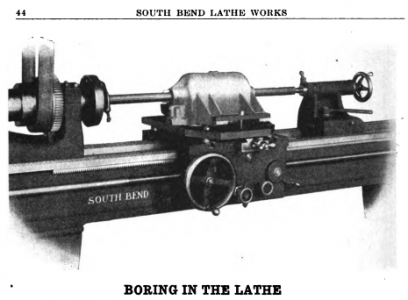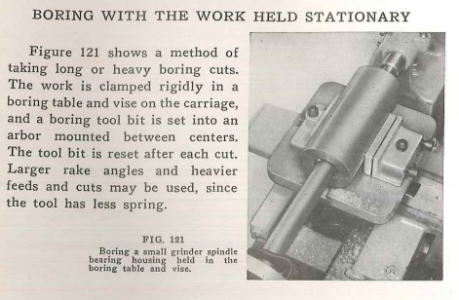I'd use a bushing carried by the lathe's carriage just past the far end of the bore, this reduces the excessive overhang of the bar, all the way out to the steady rest.
So basically (or exactly) like a follow rest of sorts? Hmm…I like that idea!
Why is it that sometimes the most obvious answer is the one that eludes me the most???

Pretty sure I could fab something up quick & dirty for the occasion. 6.5” of material + cutter would leave me 1.75” - 2” of “relief space” at the front once rear of hex bar clears cutter. Enough room for a small follow rest to fit. Heck, if I’m really worried about flex in the cutter bar (as Greg stated…good point, btw) I could make two thin (1/2”+/- wide ) follow rests - one in front & one following behind. She’d be a tight fit, but I’m getting used to that by now with this lathe. I’m sure I can make it work.
Regardless of what route I may take regarding follow rest(s) and/or bushings etc, once the initial “rough” drilling is complete & everything is set up ready to use the line boring tool, I have no intentions of removing anything from anywhere at any point until I’m finished (or at least think I’m finished). I’ll measure the rough drilled diameters at both ends before mounting, then basically rely on math alone after that. Initial set up is undoubtedly going to be critical & finicky, but if cutter bar, starting & finished diameters is known, then it’s not hard to figure out how far to protrude cutting bit out from bar after each pass. That’s my plan of attack, anyways. That’s how I’ve been doing the bottom radius on my other breeches/scope rails with good success. This will be pretty much the same procedure. The few radius’ I have done with my 3/4” bar took 12 passes @ .006” DOC & a final pass @ .003” (.075” total DOC)
For this project my final diameter of .469” - .470” isn’t carved in stone, either. I have a .020” leeway (+/- .010” of target i/d) to play with so not worried there. Barrel isn’t machined yet, so it’s basically aim for .470”, hope for somewhere between .460” - .480” & ultimately machine the barrel to suit whatever I end up with within that range. Going to be conservative considering the size of this particular cutter bar, so going to make light passes of .002” - .003” DOC for its maiden voyage & see what transpires
Not asking for much…all I want is the hole centered at both ends & straight in the middle!

Once I gain some experience & fine tune my methods with this set up, then, & only then, will I even consider trying to match an i/d to an already finished o/d.
Thanks to everyone for all the tips/advice so far…it is most definitely appreciated!






